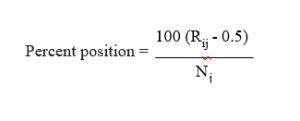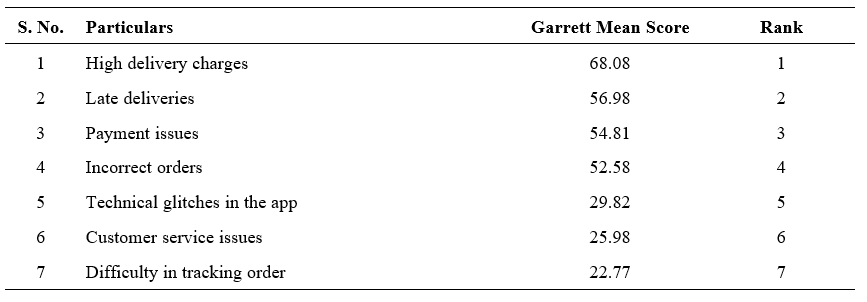Issues That Consumer Experience Towards Online Food Delivery (Ofd) Services in Tirupati City
0 Views
J.RAJITHA PRIYADHARSHINI*, M. SATHISH RAHUL, Y. PRABHAVATHI AND S.K. NAFEEZ UMAR
Institute of Agri-Business Management, S.V. Agricultural College, ANGRAU, Tirupati-517 502.
ABSTRACT
This article examines the specific challenges faced by consumers in Tirupathi city while using online food delivery services. It investigates issues such as high delivery charges, late deliveries, and payment issues are top concern followed by delivery orders. The impact of these challenges on customer satisfaction and loyalty is analyzed, shedding light on the need for enhanced quality control and improved communication between consumers and service providers in the digital food delivery services and it provides insights into the areas where improvements are needed, emphasizing the importance of addressing these concerns to enhance overall customer satisfaction in the city’s evolving food delivery services.
KEYWORDS: OFD (Online Food Delivery), Issues, Consumer, E-commerce.
INTRODUCTION
India has witnessed a remarkable surge in internet use over the past decade, with the percentage of users growing from 7.5 per cent to 50 per cent (Statista). This technological advancement has had a profound impact on the food delivery service industry, as people increasingly rely on technology for various tasks. As a result, Online food delivery (OFD) services have experienced a significant boost, with consumers embracing the convenience of ordering cooked meals and having them delivered right to their doorstep. The COVID-19 pandemic further accelerated this digital transformation, leading to a profound shift towards digital solutions that continue to persist even beyond the pandemic. The emergence of e-commerce in Online food delivery (OFD) has revolutionized how people order and receive their meals, offering a diverse range of restaurants and cuisines through online platforms. Additionally, customers benefit from improved convenience, real-time order tracking, and enhanced control over delivery times. As a result, the Online food delivery (OFD) market is expected to grow even further, catering to the busy lifestyles of individuals, especially in urban areas mostly prefer to order food in online and presenting new opportunities for businesses to expand their customer base. Tirupati is located in the southern state of Andhra Pradesh, India, is known for its religious significance and attracts many tourists and pilgrims every year. This Research is proposed to determine the consumer perception towards OFD (Online Food Delivery) services in the research area.
METHODOLOGY
The survey was conducted in the Tirupati city, where e-commerce businesses Online food delivery (OFD) services have been introduced in some metropolitan areas. As a result, Tirupati (tier-2) city, known for the expansion of Online food delivery (OFD) services were purposively selected for the present research. A simple random sampling technique was used to select a representative sample of 120 consumers from the top 4 areas in Tirupati city i.e. Vidhya nagar colony, Balaji nagar colony, staff quarters, Prakasam nagar colony. who frequently order food through Online food delivery (OFD) services such as Zomato, Swiggy, Pizzahut, Dominos, etc. Garrett ranking was used to analyze the constraints. In this method the respondents were asked to rank the factors identified for the purpose of study according to their preferences.
Garrett’s Ranking Technique
Garrett’s ranking technique was adopted for analyzing the constraints in purchasing of fruits and vegetables. In this method the respondents were asked to rank the factors identified for the purpose of study according to their preferences. Thus, the assigned ranks are calculated by using the following formula.

where,
Rij = Rank given for ith variable by the jth individual.
Nj = Number of variables ranked by the jth individual.
For each calculated per cent position, scores were obtained from corresponding Garrett’s tables.
RESULTS AND DISCUSSIONS
It is observed that high delivery charges ranked as the top customer issue in Tirupati with a Garrett Mean Score of 68.08. This suggested that customers in Tirupati frequently experience high delivery charges which can be a major source of frustration. Late Deliveries ranked second constraint with a Garrett Mean Score of 56.98, This indicated that customers in the city perceive delivery fees to be expensive or unreasonable, potentially affecting their willingness to make purchases. Payment issues ranked third constraint among customers with a Garrett Mean Score of 54.81. Incorrect orders ranked fourth constraint with a Garrett Mean Score of 52.58, incorrect orders are a common problem faced by customers in Tirupati. Technical issues in the app ranked fifth among customer issues with a Garrett Mean Score of 29.82. Customer service issues ranked sixth constraint with a Garrett Mean Score of 25.98. Difficulty in tracking orders was perceived as less problematic by customers with the lowest Garrett Mean Score of 22.77.
These results and rankings provided insights into the major customer issues faced in Tirupati city. By focusing on resolving late deliveries, optimizing delivery charges, improving payment processes, minimizing incorrect orders, and enhancing customer service, businesses can work towards creating a better shopping experience for their customers in Tirupati.
In conclusion, the survey regarding customer issues, high delivery charges ranked as the top concern, followed by late deliveries, payment issues, and incorrect orders. These findings provided critical insights for businesses to address and improve the overall customer experience in Tirupati.
Table 1. Issues that consumer experience regarding online food delivery services

LITERATURE CITED
Karthikeyan, D.G. 2016 Problems faced by Online Consumers. International Journal of Current Research and Modern Education, 1(1): 166-169.
Kuriachan, J.K. 2014 Online shopping problems and solutions. New Media and Mass Communication, 23(1): 1-4.
Malhotra, B. 2014. E-Business: Issues & Challenges in Indian Perspective. Global Journal of Business Management and Information Technology, 4(1): 11-16.
Sobha. 2016. Problems and Prospects of Online Shopping in India with Special Reference to Palakkad District, Kerala. Indian Journal of Applied Research, 6(5): 350-352
Subrahmanyam, Y and Krishna, G.M.V. 2016. Online Shopping Problems and Solutions. International Journal of Multidisciplinary Research. 2(3): 1-6.
- Morphological Characterization of Sesame (Sesamum Indicum L.) Genotypes
- Effect of Liquid Biofertilizers on Productivity of Sesame (Sesamum Indicum L.)
- Profile Characteristics of Stakeholders in the Banana Value Chain: A Gender Analysis
- Studies on Genetic Variability and Genetic Parameters for Grain Yield and Its Components in Foxtail Millet (Setaria Italica (L.) P. Beauv.)
- Morphological Basis for Resistance Against Whitefly in Castor
- Dus Testing of Sesame (Sesamum Indicum L.) Accessions Using Morphological Descriptors

